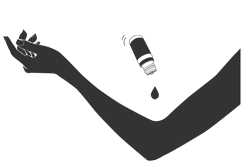We often hear about allergies related to essential oils. Indeed, certain essential oils contain allergenic molecules, which can sometimes react with certain people. But everyone is unique when it comes to this phenomenon, and if your terrain is sensitive, do not hesitate to test the HEs beforehand. Note. These allergies are rather rare, and only affect people who have suitable conditions. But as EOs are very concentrated products, they can become very widespread: susceptible people must therefore take the test. In the second chapter of this article, we will learn to tell the difference between an allergy and an irritation.
Do the allergy test in the crook of the elbow!
So, people who are easily allergic should be careful, and test the product by pouring two drops of essential oil into the crook of the elbow .
No reaction after 48 hours? A priori, everything is fine.
Allergy or irritation?
Appearance time
- Irritation: immediate appearance or after a few applications.
- Allergy: most of the time delayed onset (between 24 and 48 hours after application)
Visible signs
- Irritation: mild itching, redness, tingling.
- Allergy: edema, itching, burning. The severity varies depending on the reaction.
Affected areas
- Irritation: only the contact area will be irritated.
- Allergy: it can spread to other parts of the body.
Recovery
- Irritation: cessation of symptoms when stopping use of the product.
- Allergy: slower cessation, possibility of relapses.
Was this article helpful to you?
Average grade: 4.7 ( 730 votes)
Bibliography
Work : de la Charie, T. (2019). Treat yourself with essential oils. Why and how does it work? Editions du Rocher.
About these tips
This aromatherapy article was written by Théophane de la Charie, author of the book “Treat yourself with essential oils”, accompanied by a multidisciplinary team made up of pharmacists, biochemists and agronomists.
La Compagnie des Sens and its teams do not encourage self-medication. The information and advice provided comes from a reference bibliographic database (books, scientific publications, etc.). They are given for information purposes, or to suggest avenues for reflection: they should in no case replace a diagnosis, consultation or medical follow-up, and cannot engage the liability of the Compagnie des Sens.


